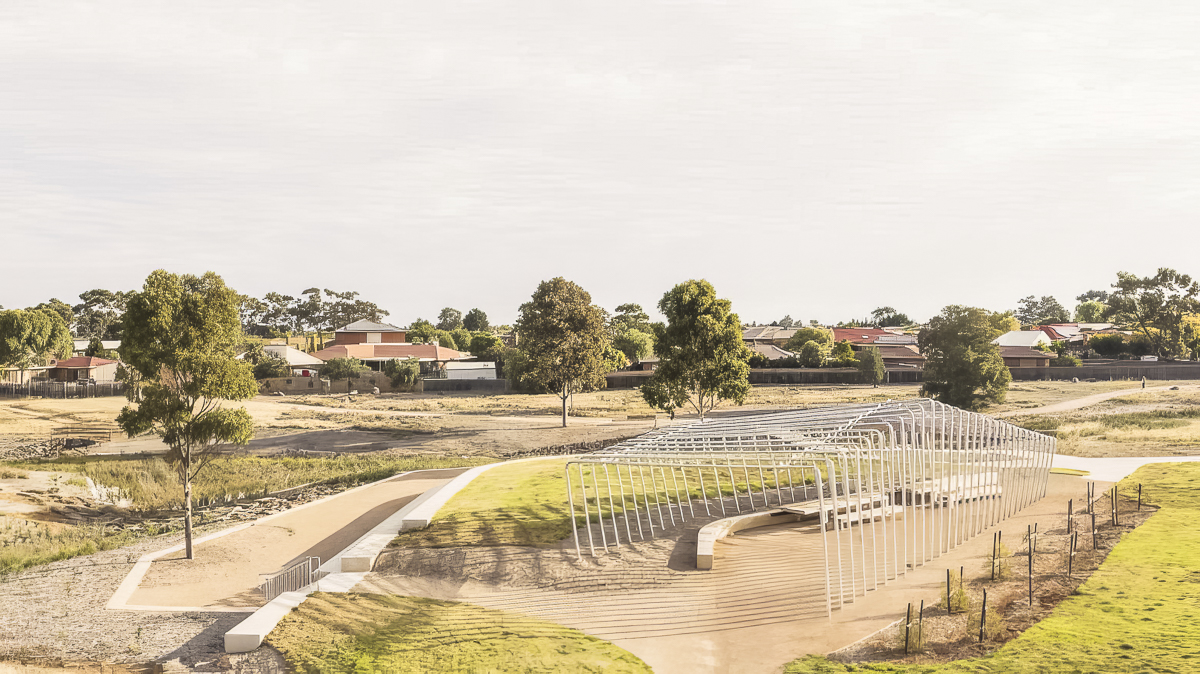The ‘Reimagine Your Creek’ project focuses on naturalising Melbourne’s waterways.
Naturalisation is a growing initiative in contemporary urban planning. It has the potential to deliver better outcomes to our waterways than just drainage alone. As opposed to restoration, naturalisation is a pragmatic approach to return natural systems and experiences to our landscapes, within the constraints of a working city. Communities do not often get the opportunity to redesign a waterway. In an urban context, these linear landscapes are often seen simply as drains. But in actuality they provide an invaluable lifeline for wildlife, vegetation and people.

History of waterway management
The 20th century was witness to an engineering movement that swept across Melbourne’s dynamic catchments. It aimed to reduce complex systems of natural rivers, creeks and tributaries into a simple ‘grey infrastructure’ of concrete channels and drains. Thankfully these views are beginning to change. Waterways are now crucial spaces to integrate our urban and natural systems.
Enhancing life and liveability
Melbourne Water is the statutory agency responsible for all water management across Melbourne’s catchments. Following its commitment to “enhancing life and liveability”, it is now reviewing how it can improve waterway health. It aims to better meet the needs of the contemporary city. Its focus now is to naturalise the concrete stormwater systems inherited from last century.
The project, ‘Reimagine Your Creek’ redesigns a series of urban creeks to ‘naturalise’ them. It is revealing how Country benefits from slowing water down as it moves through the city. Gone are the days of straight-lined concrete channels taking this valuable resource on the fastest route to the bay.

How to naturalise a waterway
When designing a naturalistic system, the bed grade is flattened to lengthen the flow path. This leads to a waterway with natural meanders instead of straight concrete channels. These meanders result in gentler, less erosive flows which helps hold water in the landscape in soils and in plant life.

Benefits of naturalising waterways
Naturalisation can also bring much needed attractive open green space to communities otherwise underserved in this regard. ‘Reimagine your Creek’ targeted four creeks in lower socio-economic areas of Melbourne which were short of open space. Altogether this project has seen human life flow back to over five kilometres of waterways previously underutilised by their communities.
Extensive consultation undertaken
Critical to the transformation of these waterways was extensive consultation with their surrounding communities. The consultation process revealed a community desire to engage with water. They were keen to hear it and see it flowing, to touch and smell it. The community wanted a waterway that looked like a natural waterway, not like a drain. They wanted to invite nature to come back into the city.
The design recreated ecological and hydraulic features that provide opportunities for the community to connect with water. One symbolic feature of creek naturalisation was the introduction of stepping stones. This led people down into the creek bed and across it. Water travels between the rocks to hurry and rush with trickles, riffles and ripples. This in turn creates an audible and visual experience.

Outcomes of naturalising Melbourne’s waterways
Life and activity has been quick to return to the waterways since the completion of the project. Humans and non-humans alike are finding their place in the naturalised sections. Once, there was no chorus of bird’s sounds. Now that chorus is all around, along with frog croaks rippling out in the background. And a steady trickle of joggers can be heard deep in conversation.
One of the exciting things about these projects is that they are dynamic. It is possible to manage water. But over time it will dictate its own expression. Although engineering has fixed the course of the waterways, the design approach supports movement and change to occur over time, particularly by visitor engagement with the landscape. Some species will come to the fore in wet seasons, and in drier seasons others will come to dominate. The creeks themselves will become vehicles for seed movement.

Plantings are complex mosaics
Plantings are intentionally complex mosaics, with arrangements intended to continue evolving over the coming years. While some species populations will shift from year-to-year, others will be quick in establishing a short-term dominance. Movement in these creeks is about much more than water. We need to recognise that water is a fundamental and dynamic element of Country, especially in our urban environments. There is such power in the Australian landscape; we have to release that.
The ‘Reimagine Your Creek’ project achievements were recognised by AILA Victoria’s 2021 awards, winning an Award of Excellence for Infrastructure.
 Australian Native Plants Society (Australia)
Australian Native Plants Society (Australia)












